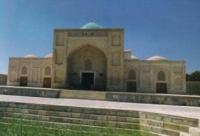You are here
Tash Mosque in Wangazi.

Tours of historical and architectural monuments of the Bukhara region.
“In order to come closer to historical truth, one must go two ways at the same time - thoroughly, impartially, critically study events and, connecting the researched, conclude that it cannot be obtained in the first way”
Wilhelm von Humboldt.
An Uzbekistan and Central Asia Silk Road.
The Tash-mosque ensemble in the village of Vangazi (50 km east of Bukhara), like the Gaukushan ensemble, was built under Abdullah Khan II. Probably, there was the burial of a respected Sufi person around whom a cemetery with a mosque had appeared.
At the direction of Khoja Abu Bakr Sadad, the old frame mosque was destroyed, and in 1580 - 1586 a khanaka was built there with a monumental pillar-domed hall. Later, she took over the functions of the quarter and Juma mosques.
Thanks to the supporting structures made of baked brick, such buildings were called Tash mosques, i.e. stone mosques. Near the Tash Mosque there used to be madrasas and a bath complex that has not survived to our days.
A slim minaret, representing a reduced copy of the Waqkent minaret, remained intact. It was the highest erected in the XVI century. Its height is 24 meters with a lower diameter of 3.8 meters. The base and the foundation are made of stone.
The trunk of the minaret of Vangazi is decorated with six belts of relief masonry and completed with an eight-arch lantern with a stalactite cornice.
Enlightener:
VG Saakov "History of Bukhara". Shark Publishing House, 1996. “Bukhara. Masterpieces of Central Asia. Historical guide to Bukhara. year 2012. "Bukhoro Bukhara Bukhara" In Uzbek, English and Russian. Publishing House "Uzbekistan", Tashkent 2000. Muhammad Narshahi. History of Bukhara. Tashkent. 1897 (translated by N. Lykoshin). V.G. Saakov Architectural masterpieces of Bukhara. Bukhara regional society "Kitabhon" Uz SSR, Rovno 1991, Robert Almeyev. The history of ancient Bukhara. (Edited by Academician of the Academy of Sciences of the Republic of Uzbekistan Rtveladze E.V.).







